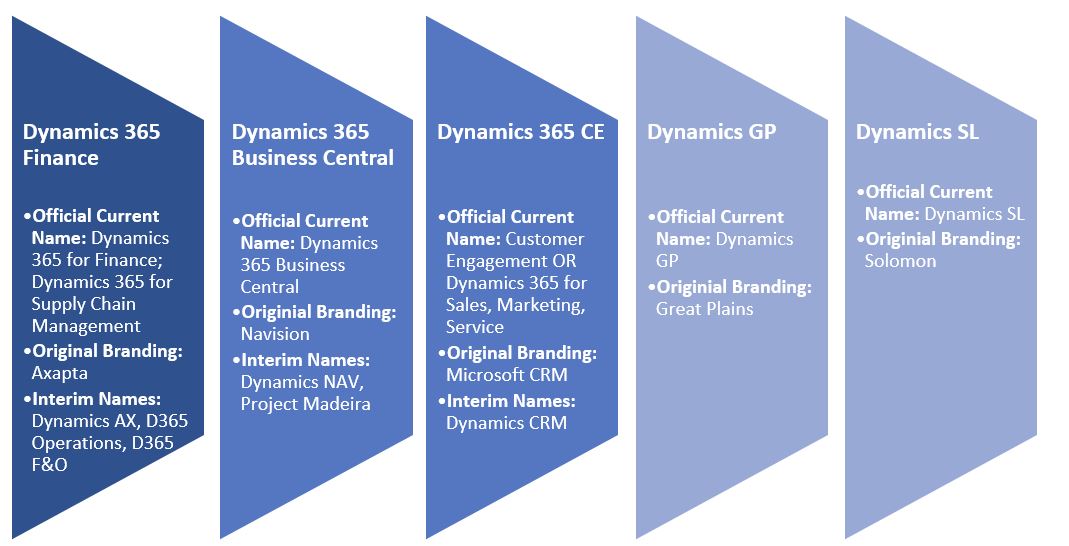Microsoft’s impressive array of CRM and ERP offerings make it a powerhouse in the business applications market today. Deep-seated market presence and continuous development efforts have created application maturity and reliability. However, the evolution of these systems and frequent changes to brand naming conventions often creates confusion for customers interested in today’s product offerings.
Current and former ERP and CRM clients as well as organizations deliberating a first-time purchase of Microsoft business solutions are often left with questions about the extensive suite of Dynamics applications. For example: What is the difference between Dynamics AX and Dynamics 365 for Finance? My organization used Great Plains in the past; will our experience with Dynamics 365 Finance look the same? Which applications are seeing Microsoft’s heavy investment efforts today?
This blog explains the evolution of Microsoft’s Dynamics suite of ERP and CRM products that we know today. We will see where the company’s business application arm originated, how it successfully expanded, and clarify product lineage to today’s offerings. We hope to clear up any confusion and help potential customers make informed decisions for their organization’s ERP and CRM solutions.
Early history of Microsoft ERP
In the early 2000s, Microsoft saw its opportunity within the business solutions market. Key leaders were aware of the early success of accounting software in the 80’s and 90’s and made the strategic decision to expand business offerings outside of core infrastructure. Microsoft’s first plan of action was to acquire four rapidly growing accounting systems: Axapta, Navision, Great Plains and Solomon. Between 2002 and 2005, the newly acquired programs were intermittently released as fully branded Microsoft products. Among the ERP rollouts, Microsoft also released its first Customer Relationship Management (CRM) solution in 2003.

Introducing Microsoft Dynamics
In 2006, Microsoft transitioned to a large-scale rebranding of the business solutions line, electing “Dynamics” as the new captivating and emblematic brand name to serve the evolving product line from that point forward. The rebranding also entailed abbreviations, and the names we are perhaps more familiar with came into being: Axapta became Dynamics AX, Navision became Dynamics NAV, Great Plains became Dynamics GP, Solomon became Dynamics SL, and Microsoft CRM became Dynamics CRM.

Push to the cloud
By 2015, all five of Microsoft’s business applications were growing at a promising rate. As the marketplace saw a large-scale push to the cloud, Microsoft accelerated its development of select solutions into cloud offerings. Dynamics CRM was the frontrunner in solidifying robust online offerings, while ERP cloud developments were soon to follow. Dynamics AX, being Microsoft’s singular enterprise class ERP product, was the first focal point for cloud development. Next, among its three mid-market ERP options, Microsoft chose to redevelop Dynamics NAV as its primary focus, for the comparatively simplest code manipulation. Microsoft’s first cloud releases came in 2016 for Dynamics AX and in 2018 for Dynamics NAV.
Introducing Dynamics 365
We saw the largest changes to Microsoft’s ERP landscape through the introduction of the Dynamics 365 (D365) umbrella. The catalyst for the change was the development and rebranding of Dynamics AX. Leading up to the release of AX7 in 2016, Microsoft took major development strides to remain on the cutting edge of robust, innovative ERP offerings. Noteworthy advancements included major revisions to the User Interface and the new cloud delivery. A year after the initial release, Dynamics AX (AX7) was rebranded as Dynamics 365 for Finance and Operations. In recent months, Dynamics 365 for Finance and Operations is now offered as two individual applications: Dynamics 365 for Finance and Dynamics 365 for Supply Chain Management.

Meanwhile, Dynamics CRM joined the D365 suite. In 2016, Microsoft retired Dynamics CRM, replacing it with Dynamics 365 for Customer Engagement.

Shortly after its new online release in 2018, Dynamics NAV entered the Dynamics 365 line. Microsoft retired the Dynamics NAV name and redefined the product as Dynamics 365 Business Central.

Current branding
The graphic below portrays Microsoft’s five main ERP and CRM product offerings today, including detail about original branding and interim brand names.

Market focus and development efforts
Each of Microsoft’s ERP and CRM products may still be suitable for the specific needs of an organization; however, Microsoft has not been shy in emphasizing that its current and future investment efforts lie heavily within the Dynamics 365 suite of cloud products, as part of Microsoft’s key strategy to move customers to the cloud. This means the spotlights for advancement include cloud-based D365 Finance, D365 Supply Chain, D365 Business Central and D365 Customer Engagement, while Dynamics GP and Dynamics SL will receive less attention. This is paramount for new customers to consider, as the greatest return on investment will undoubtedly come from the Dynamics 365 product line. It is also important to note that D365 provides impressive purchasing flexibility, with the freedom to add new modules and tiered licenses as business needs expand, providing unmatched potential for scalability.
Additionally, Microsoft’s current focus on the Power Platform is an attractive pull for Dynamics customers. The Power Platform is the collective term for three Microsoft products: Power BI, PowerApps, and Power Automate. These applications, available to most organizations already utilizing Microsoft Office 365 subscriptions, can be used in tandem with D365 ERP and CRM products in order to automate activities, both custom or native, within the system. These innovative applications, along with the integration of Office tools (i.e. Excel, SharePoint, Outlook, etc.) maximize product usability and provide opportunities for powerful efficiency gains.

Conclusion
Microsoft’s ERP and CRM business applications provide organizations with powerful solutions to run their business, with the D365 product line promising a particularly powerful return on investment. We hope today’s blog has cleared up common confusion and equipped individuals and organizations to make informed purchasing decisions.
To learn more about Protiviti’s Microsoft consulting services, contact us.



